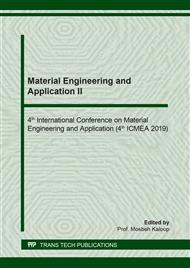p.48
p.54
p.59
p.64
p.70
p.76
p.82
p.87
p.94
Study on Morphology Features and Mechanical Properties of Nanofibers Films Prepared by Different Composite Electrospinning Methods
Abstract:
Electrospinning is an important method for preparing nanofibers, which are highly promising for applications in a wide range of fields such as purification/filtration, photoelectric devices, battery separators, catalysis and tissue engineering. These applications often use composite materials and have specific requirements for mechanical properties. Therefore, how to get nanofibers films with ideal mechanical properties by changing the composite mode is an important process problem for the given two or more materials. Based on the far-field electrospinning, this study selected polyacrylonitrile (PAN) and thermoplastic polyurethane (TPU) to explore the differences of three composite methods: mixed spinning, multi-nozzle simultaneous spinning and superposition spinning. Three kinds of analysis can be seen in this study, which include morphology features, thickness measurement and mechanical properties of samples. Multi-nozzle simultaneous spinning has very limited changes. Mixed spinning and superposition spinning are beneficial to the improvement of nanofibers films morphology and mechanical properties. Among them, the composite films through superposition spinning are thinner.
Info:
Periodical:
Pages:
70-75
Citation:
Online since:
May 2020
Authors:
Price:
Сopyright:
© 2020 Trans Tech Publications Ltd. All Rights Reserved
Share:
Citation:


